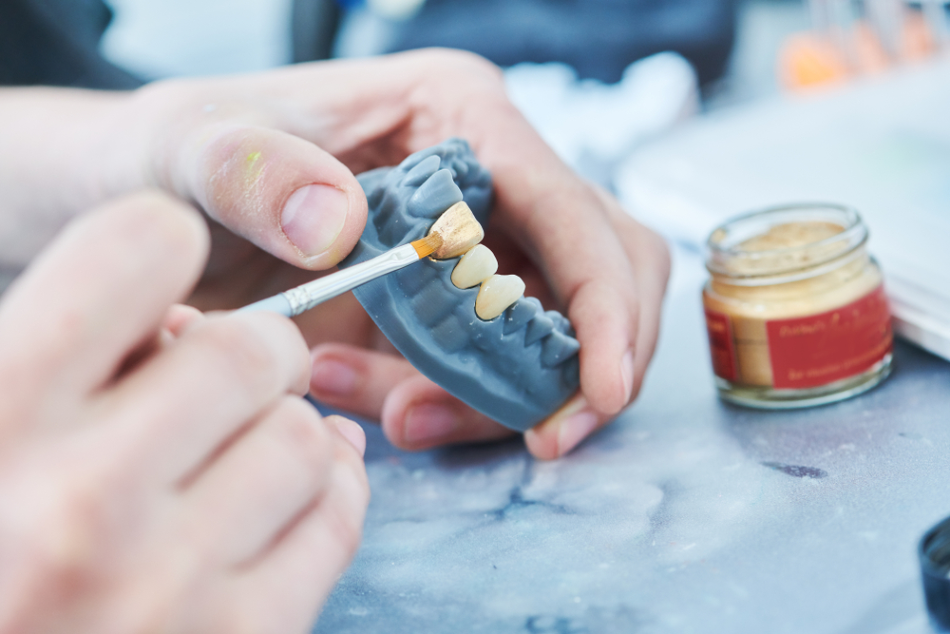A new generation of dental restorative materials is being developed thanks to advancements in nanotechnology.

Image Credit: Dmitry Kalinovsky/Shutterstock.com
Now, dentists can opt to use materials made from a nanoparticle mixture that better resemble teeth rather than relying on metal alternatives that can have the impact of damaging teeth, alongside standing out for their color differences. This is just one example of how nanotechnology is improving dental materials.
The last few years have seen several next-generation materials emerge onto the dental market with the help of nanotechnology. Below, we discuss how these new materials that incorporate nanotechnology are being used for many applications in restorative dentistry, including rebuilding enamel, helping teeth to self-heal, and protecting the mouth from damaging bacterial infections.
Antimicrobial Dental Nanomaterials
Silver nanoparticles are being used to defend against biofilms, such as dental plaque, due to their ability to prevent bacterial growth by attacking numerous sites in the cell simultaneously while being at a very low concentration.
This is important as there is a concern for developing dental applications with silver nanoparticles, because the particles are small enough to cross the blood-brain barrier. Studies have shown their association with decreasing mitochondrial function in murine neuroblastoma cells and other cells, as well as having the impact on adding to oxidative stress and inflammation.
Titanium dioxide-based nanoparticles have also shown their use in protecting the teeth from bacterial growth.
When exposed to near-UV and UVA wavelengths the particles go under photocatalysis, resulting in the generation of reactive oxygen species that have the impact of amending the osmotic equilibrium of bacteria. However, much more research is needed to determine their toxicological effects.
Copper-based nanoparticles can also fight bacterial growth, however, the exact mechanism of how they work remains unclear. It’s suggested that copper can bind to amine and carboxylic groups on the microorganism’s surface, resulting in alterations to their membranes that destroy them. Again, more research is needed to help develop their use in dental materials.
Chitosan nanoparticles are another potential antibacterial agent, however, again more research is needed to confirm the low toxicity shown in previous studies.
Therapeutic Dentistry
Therapeutic dentistry intends to protect teeth and keep them healthy without the use of surgical methods. It treats diseases of the oral cavity and surrounding tissues with a range of therapies that do not involve surgery.
Nanoparticles are emerging as a useful strategy for facilitating targeting drug delivery to cells and tissues. They have proven themselves effective at delivering uniform drug concentration to an injury location.
Dentistry has picked up on this use of nanoparticles and has created nanoparticles that incorporate cisplatin that is effective in acting against oral squamous cell carcinoma. Also, nanoparticles have been designed that have been successfully used as vehicles for hydrophobic chemotherapeutics in oral squamous cell carcinoma, showing improved drug stability, and a decreased risk of proteolytic degradation.
Preventing tooth decay
Conventional restorative polymeric fillings do not present bioactivity. Bacterial organisms that exist in the mouth make it difficult to establish effective new dental materials, however, nanotechnology is currently being used to produce bioactive dental materials that can affect caries-related bacteria. A combination of calcium phosphate and metallic particles has proven particularly effective at developing restorative materials, as they have been shown to decrease mineral loss from the teeth and actively fight caries-related pathogens.
Nanocomposites as fillings
In terms of clinical use, nanocomposites and dental materials containing nanoparticles are currently the nano-based dental materials that are most viable for clinical use. Some of these materials are already commercially available.
They have found success due to their ability to fill more of the cavity than materials that use microparticles. However, research is still underway checking the impact of inhaling the nanoparticles used in the materials during processes such as re-shaping and polishing.
Sources:
https://www.sciencedaily.com/releases/2015/10/151019130757.htm
https://www.cell.com/trends/biotechnology/fulltext/S0167-7799(15)00191-2?_returnURL=https%3A%2F%2Flinkinghub.elsevier.com%2Fretrieve%2Fpii%2FS0167779915001912%3Fshowall%3Dtrue
https://www.ncbi.nlm.nih.gov/pmc/articles/PMC3845439/
Disclaimer: The views expressed here are those of the author expressed in their private capacity and do not necessarily represent the views of AZoM.com Limited T/A AZoNetwork the owner and operator of this website. This disclaimer forms part of the Terms and conditions of use of this website.